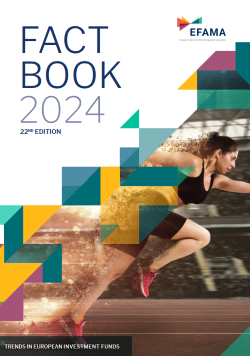Net assets of UCITS and AIFs doubled over the last ten years, reaching EUR 20.7 trillion in 2023
EFAMA has today published its 2024 industry Fact Book. This year’s edition includes a foreword by EFAMA President, Sandro Pierri, in-depth analyses of trends in the European investment fund industry (for 2023 and over the longer term) and an extensive overview of regulatory developments across 29 European countries. It also contains a series of info-boxes addressing some important regulatory issues EFAMA is actively working on, including DORA, ELTIF, ESG ratings, withholding taxes, retail investment, sustainability disclosures, global fund distribution and T+1 settlement.
Key highlights on the long-term industry trends include:
- Large funds are becoming increasingly important in the UCITS market– UCITS funds smaller than EUR 100 million accounted for less than 4% of the total net assets of UCITS in 2023, with a market share that is gradually falling. At the same time, the share of the funds with more than EUR 1 billion in net assets is increasing.
- The cost of long-term UCITS continued to fall – During the 2019-2023 period, the average cost of active long-term UCITS decreased from 1.16% to 1.06%, while the cost of passive long-term UCITS declined from 0.23% to 0.21%. This trend is expected to continue, driven by heightened transparency for fund fees and intensified competition between asset managers.
- Passive UCITS continue to gain market share– The market share of passive UCITS rose from 11% in 2013 to 26% at end 2023. This trend can be attributed to a combination of lower costs for passive funds and increasing investor demand for ETFs.
- Foreign investors are increasingly significant buyers of EU investment funds – Over the past five years, foreign investors bought EUR 276 billion of EU investment funds on average annually. In comparison, EUR 174 billion was sold cross-border within the EU and EUR 196 billion was purchased domestically.
- The share of US stocks in the asset allocation of equity UCITS has risen sharply – The share of US stocks doubled from 22% to 44% over the past decade. This is due to US stock markets outperforming those in Europe, particularly the large US technology stocks.
Additional key findings for 2023:
- ETFs had a record-breaking year – UCITS ETFs attracted EUR 169 billion in net sales in 2023. Non-ETF long-term UCITS on the other hand, saw net outflows of EUR 155 billion throughout 2023.
- Sales of sustainable funds slowed down – Net sales of SFDR Article 9, ‘dark green’, funds, declined compared to 2022. Conversely, Article 6 (no sustainability focus) funds saw a turnaround, attracting EUR 41 billion in net inflows. These trends were mainly driven by the rising popularity of ETFs, as most ETFs are Article 6.
- Average annual performance of all major UCITS types was positive– Equity UCITS delivered on average 14.2%, multi-asset UCITS yielded 8.7%, bond UCITS 5.7% and money market funds 3.3%. With the EU inflation rate at 3.4% for the year, most UCITS proved to be an excellent investment choice in 2023.
- EU retail investors continued to buy funds in 2023, but shifted their focus towards bonds – Given the reluctance among banks to raise interest rates on savings accounts, national governments in countries such as Italy and Belgium successfully attracted domestic retail savers by offering higher-yielding bond issuances.
EFAMA’s Director General, Tanguy van de Werve commented:
“This year’s Fact Book shows that UCITS are delivering good returns with costs declining, attracting both European and foreign investors. While this is good news for the financial wellbeing of those investors, there are still far too many European households not reaping the benefits of investing in capital markets. This is a pivotal year of change within the EU institutions, with clear recognition from policymakers that we need to encourage more retail investing to address the pension gap and support economic growth. To achieve that, we need decisive actions that simplify investing, cut red tape, and move us closer to a Savings and Investments Union.”
- ENDS -
Notes to Editors
Graphs and country-specific data are available for reproduction.
For further information, please contact:
Hayley McEwen
Head of communications and member development
About the Fact Book
The Fact Book is one of EFAMA’s flagship publications. A digital version of the Fact Book is freely available on the EFAMA website.
An Excel-based statistical package is available for purchase, featuring data on the five largest asset managers in most European countries and over 50 tables with historical time series on net assets, net sales, and the number of UCITS and AIFs at the country level.
Additionally, a separate Excel package, including all 175+ charts from the Fact Book main analysis, is also available for purchase.




























